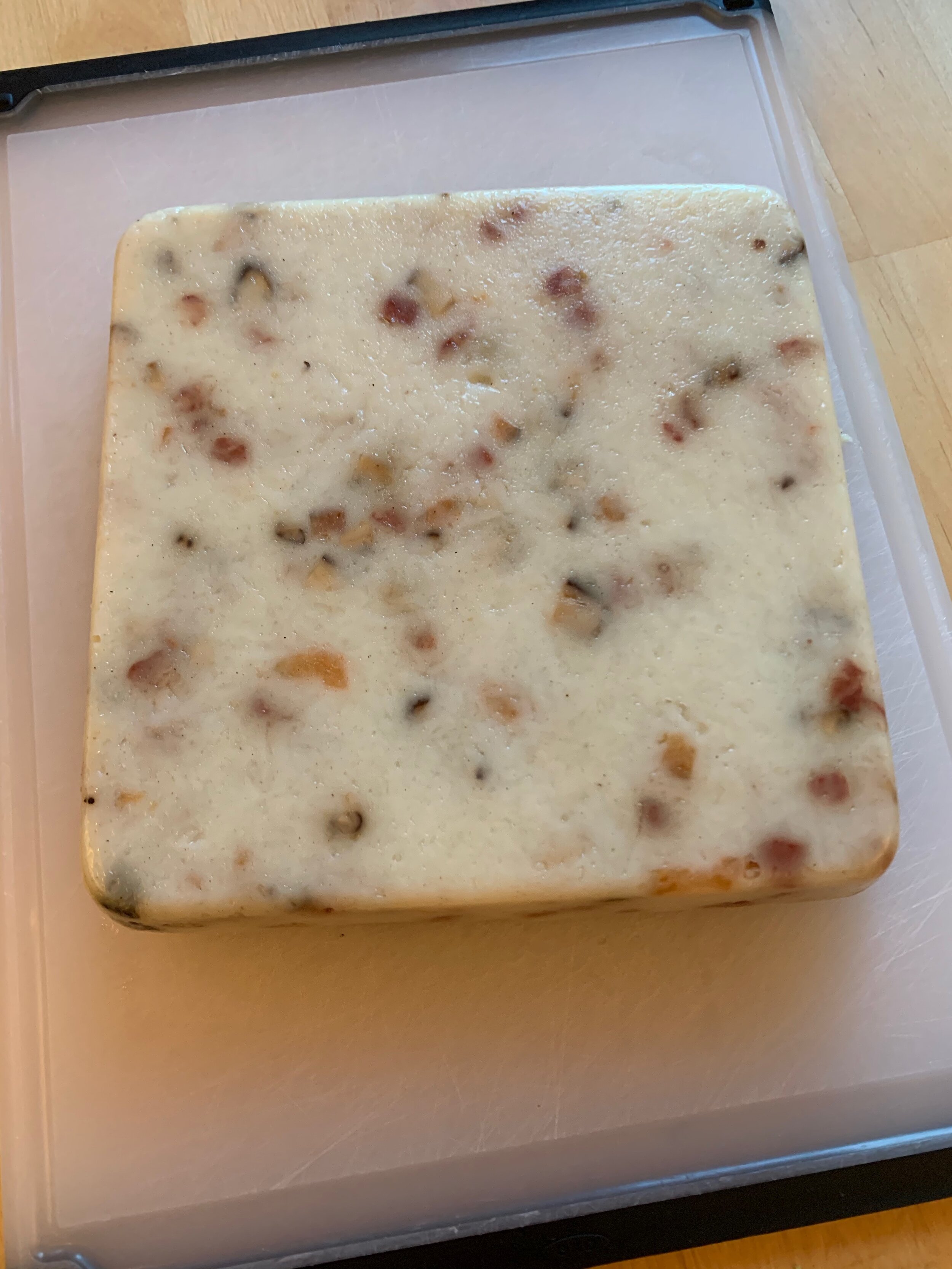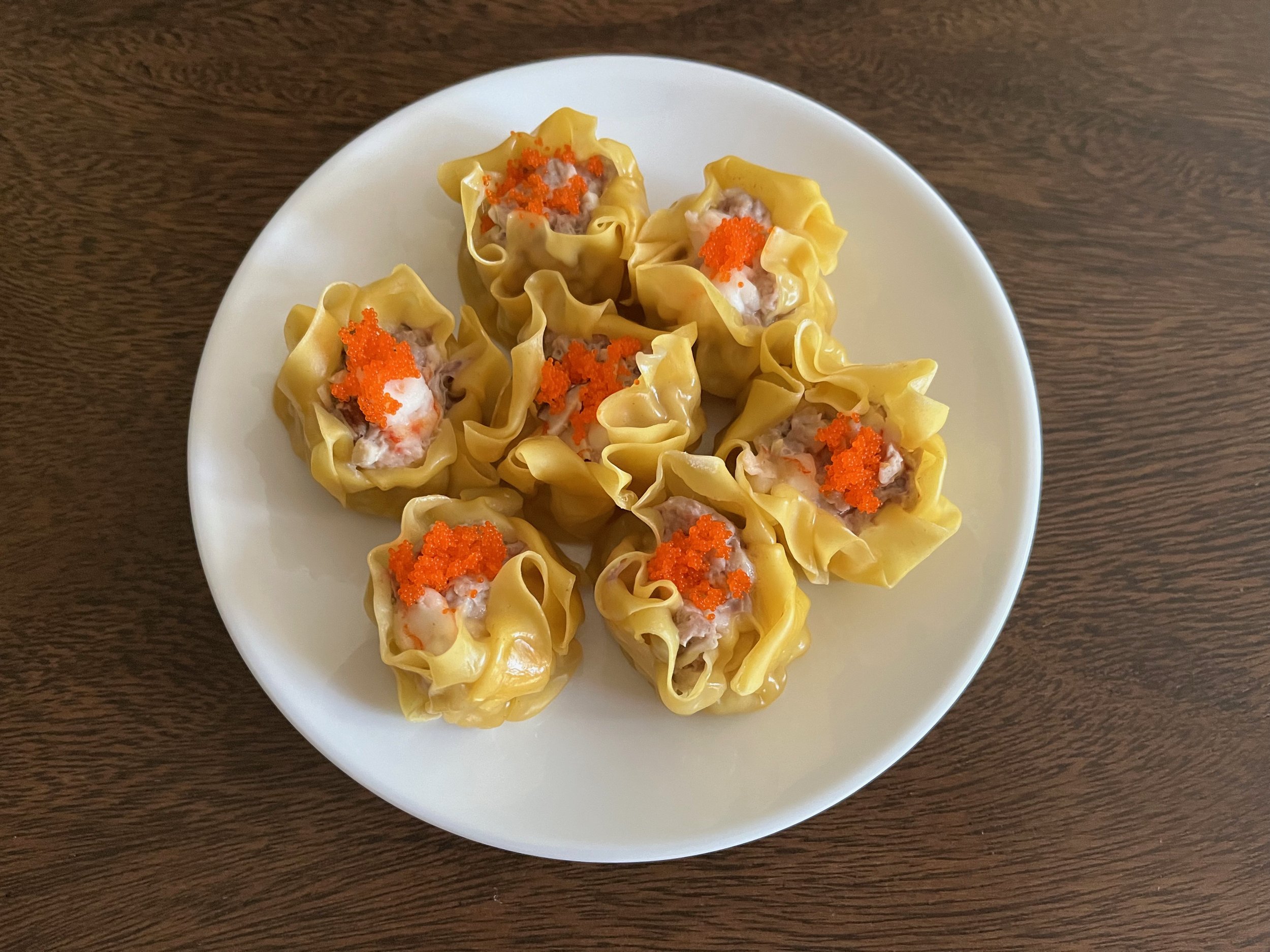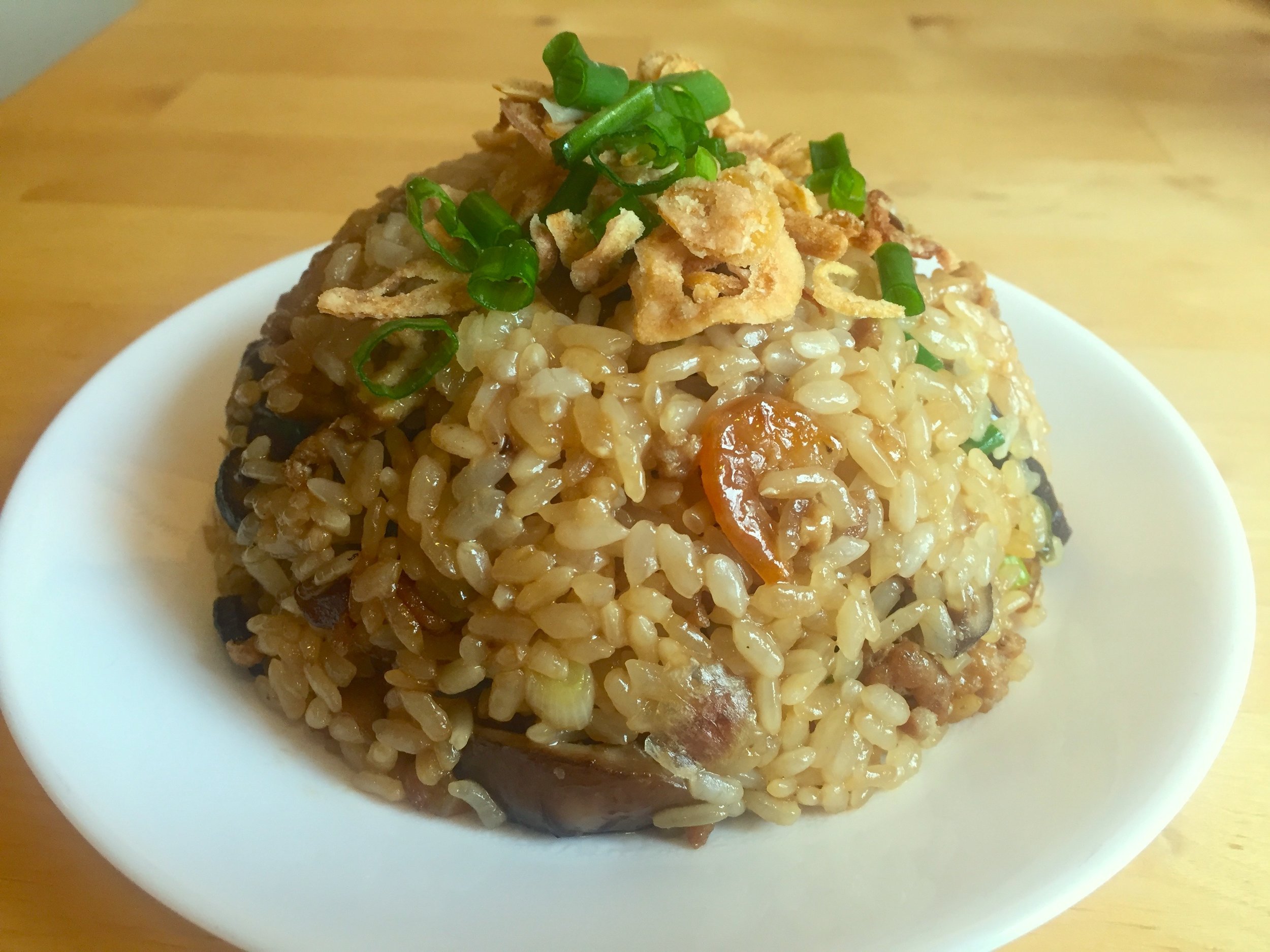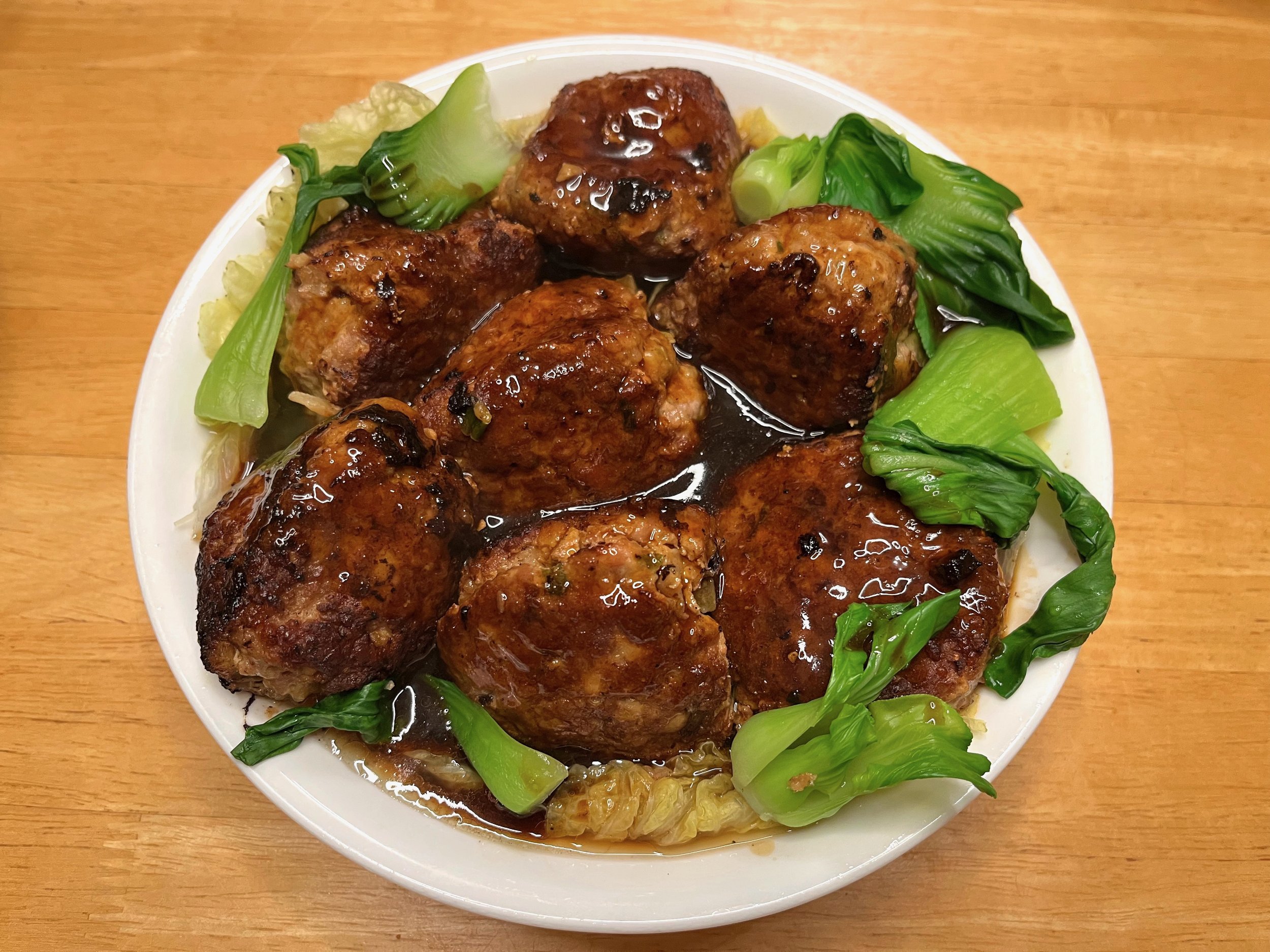Turnip Cake

蘿蔔糕 (Luo Bo Gao)
Turnip cakes—luo bo gao in Mandarin, or lo bak gou in Cantonese—are a dim sum staple. Made from daikon radish, [1] a turnip cake at its best is crispy on the outside, soft and tender on the inside, and flavored with bits of cured pork and shrimp.
However, at many dim sum restaurants, the humble turnip cake languishes forgotten, overshadowed by the dumplings and the rice noodles. Often, you will find greasy turnip cakes with tough interiors, with no bits of pork or shrimp to be seen. In my opinion, turnip cakes are one of the dim sum items most worth making at home. Compared to its brethren on the dim sum cart, turnip cakes are relatively easy to make, and it is easy to improve upon the average restaurant version. We will cram our homemade turnip cakes full of savory bits and pieces: Chinese sausage, shiitake mushrooms, and dried shrimp.
Ingredients
2 lb daikon radish
1½ cups rice flour
2 tbsp cornstarch
½ tsp salt
¼ tsp white pepper
1 tsp sugar
2 Chinese sausages, diced
4 shiitake mushrooms, diced
2 tbsp dried shrimp, chopped
Vegetable oil
Begin by peeling and grating your daikon—a box grater or mandolin works best for this. When you are done grating, transfer the daikon to a large pot. Add 1 cup of water and bring the pot to a gentle simmer. We want the daikon to cook and soften, but not brown, so stir constantly. Cook the daikon for about 10 minutes, until it has softened and turned translucent.
Pour the cooked daikon out of the pot and into a large mixing bowl, together with its cooking liquid. We are looking for about 1 cup of cooking liquid, so if you are worried that you had a particularly juicy daikon, or evaporated a lot of the water, go ahead and measure the liquid separately before adding it to the mixing bowl.
While the daikon cools, we can prepare the ingredients we will be mixing into the batter—Chinese sausages, shiitake mushrooms, and dried shrimp. Dried shrimp are pretty tough, so soak them in hot water for about 5 minutes before chopping them. Since all of these ingredients will be mixed through the batter and appear as small bits in the final cake, we want them to be chopped pretty finely—we’re looking for a ¼ inch dice on everything. Heat about 1 tablespoon vegetable oil in a pan over medium heat (or, if you have some pork or duck fat lying around, this is a great time to use it).
Add the chopped sausages, mushrooms, and shrimp to the pan, and fry for about 10 minutes. By this time, the mushrooms should have cooked through and given up much of their moisture, and the sausages have rendered much of their fat. The ingredients have also flavored the oil they have been cooking in—oil which in turn will be added to the batter to permeate the cake with these savory flavors. Turn off the heat, and set the sausage mixture aside.
Next, we have to add the starches which will bind the cake together. Both cornstarch and rice flour gelatinize quickly upon contact with boiling water, and can form unpleasant lumps of flour if poured directly into a hot mixture. This is why we let the daikon cool before mixing it in. It’s fine if the daikon is still warm, but we just don’t want it to be piping hot. To further improve the probability of getting a smooth batter, we will mix the starches into the daikon in installments—first the cornstarch, then a stir, then the rice flour, ¼ cup at a time, again stirring until incorporated each time.
The amount of rice flour in this recipe is close to the bare minimum necessary to bring the batter together. This will help us achieve a moist and tender interior to our turnip cake. However, too moist and the cake will fail to set! We are looking for a smooth, thick batter which is just able to be poured. Depending on the humidity and the moisture content of your daikon, you may have to adjust the amount of rice flour slightly. When you are happy with the consistency, add the salt, white pepper, and sugar, and mix until uniform.
Add the sausage mixture to the batter, being sure to pour in all of the oil and rendered fat in the pan (fat is flavor! And the amount we’re talking here is not that much, all told). Stir until the mix-ins are uniformly distributed in the batter.
Next, thoroughly grease a nonstick baking dish or loaf pan. The dish should be large enough to hold the batter, but must be small enough to fit into your steamer. To get the traditional shape of the final cake, a rectangular dish is best, but any heat-safe vessel that fits in the steamer will do—pie dishes or large bowls can work! Pour the batter into your greased dish, and level the top of the cake with a spatula. Then bring the water in your steamer to a boil. This is a long cook, so use a generous amount of water. Place your turnip cake into the steamer basket, and steam, covered, for 1 hour.
At the end of the hour, the cake may still be sticky and a bit jiggly. This is fine, as the cake needs to cool to set completely. Remove the cake from the steamer and let cool for at least 1 hour. By the end of this hour, the cake should be a solid (but still delicate) mass. If you are storing the turnip cake for future consumption, cover and refrigerate. Some enjoy eating steamed turnip cake without frying, and there also exist some recipes which call for stir-frying turnip cake with other ingredients![2]
If you are looking for the classic dim sum cooking method, however, begin by turning your turnip cake out onto a cutting board. If your cake is sticking, loosen the edges with a knife. Then, we will portion the cake into ½-inch thick slices. Only cut what you are planning to serve—the rest can be refrigerated for another time. The turnip cake will be a bit sticky, so to get clean cuts, use a sharp knife dipped in water, and clean the knife between cuts.
When you are ready to fry, heat about 1 tablespoon vegetable oil in a nonstick pan over medium heat. Place the turnip cake pieces into the pan in a single layer. Fry for about 5 minutes on the first side, and don’t go pushing the pieces about the pan. Remember that the turnip cake slices are both sticky and delicate, so treat them like pieces of fish: don’t move them once they hit the pan, and flip only once. When the first side is golden brown, flip the turnip cakes and fry on the second side for another 5 minutes. Once both sides are golden brown and crispy, remove from the pan. Serve immediately, with oyster sauce and/or chili sauce for dipping!
Substitutions
If you like chunks of daikon in your turnip cake, you can prepare ¼ cup of extra daikon, diced into ½ inch cubes. Mix these raw daikon chunks into the batter together with the rest of your mix-ins. You can substitute the Chinese sausage for Jinhua ham, or pancetta if you can’t find Chinese ham. You can also add dried scallops to the mix-ins. If you want to make this dish vegetarian, omit the meat and shrimp, and increase the amount of mushrooms. Finely chopped carrot also works well as a mix-in.
[1] Daikon comes from the Japanese name for the vegetable (大根), which literally translates to “big root.” In most East Asian Languages the terms for radish, turnip, and carrot are interchangeable, which leads to a great deal of confusion when translating. This confusion explains how a dish with daikon radish as its primary ingredient got named “turnip cake.”
[2] This preparation, known as chai tow kway (菜頭粿), is a Chaoshan dish popular in Indonesia, Singapore, and Malaysia.
Recipe
Prep Time: 20 min Cook Time: 1 hr 30 min Total Time: 2 hrs 50 min
(+1 hr inactive)
Difficulty: 3/5
Heat Sources: 2 burners
Equipment: box grater, pan, pot, nonstick baking dish or loaf pan, steamer
Servings: 8
Ingredients
2 lb daikon radish
1½ cups rice flour
2 tbsp cornstarch
½ tsp salt
¼ tsp white pepper
1 tsp sugar
2 Chinese sausages, diced
4 shiitake mushrooms, diced
2 tbsp dried shrimp, chopped
Vegetable oil
Instructions
1. Peel and grate the daikon, and place the grated daikon in a large pot.
2. Add 1 cup of water to the daikon, and bring the pot to a gentle simmer. Simmer for 10 minutes, stirring constantly so that the daikon does not brown, until the daikon has softened. Pour the daikon and the cooking liquid into a large mixing bowl, and let cool.
3. Soak the dried shrimp in hot water for 5 minutes or until softened. Then chop the sausages, mushrooms, and shrimp into ¼-inch pieces.
4. Heat about 1 tbsp vegetable oil in a pan over medium heat. Add the chopped sausages, mushrooms, and shrimp to the pan and fry for about 10 minutes, or until the mushrooms are cooked and the sausages have rendered much of their fat. Remove from the heat and let the sausage mixture cool in the pan.
5. Return to the bowl with the daikon. Add the cornstarch, followed by the rice flour in ¼ cup installments, stirring constantly. Then add the salt, white pepper, and sugar, and mix until the batter is uniform.
6. Add the sausage mixture to the batter, including all of the oil and rendered fat in the pan. Mix until the sausage, mushroom, and shrimp pieces are well distributed.
7. Thoroughly grease a nonstick baking dish or loaf pan small enough to fit in your steamer basket. Pour the batter into the dish, and level the top with a spatula.
8. Bring the water in your steamer to a boil. Place the dish in the steamer basket and steam for 1 hour.
9. Remove the dish from the steamer and let rest, uncovered, for 1 hour. During this time, the turnip cake should set. If serving immediately, proceed with the frying steps below. If not, cover and refrigerate until ready to serve.
10. Loosen the edges of the cake with a knife, then turn it out onto a cutting board. Using a sharp knife dipped in water, slice the turnip cake into ½-inch thick pieces.
11. Heat about 1 tbsp vegetable oil in a nonstick pan over medium heat. Place the turnip cake pieces into the pan in a single layer. Fry for about 5 minutes per side, flipping once, until both sides are golden brown and crispy.
12. Remove from the pan, and serve immediately, with oyster sauce and/or chili sauce for dipping.




























